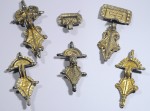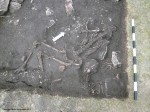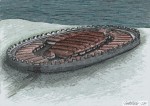 If we ever want to find out what happened at the Sandby Borg ringfort in the 5th century A.D. that left dead bodies to rot where they fell and treasure hidden for 1,600 years, we’re going to have to contribute funds. Sandby Borg was discovered on the island of Öland off the southeastern coast of Sweden in 2010 when the presence of looting pits alerted archaeologists to the site. A scan with metal detectors found five hoards each containing highly decorated gilded silver brooches, finger rings, silver bell pendants and glass beads with millefiori designs, buried in the corners of five houses in the central block of the fort.
If we ever want to find out what happened at the Sandby Borg ringfort in the 5th century A.D. that left dead bodies to rot where they fell and treasure hidden for 1,600 years, we’re going to have to contribute funds. Sandby Borg was discovered on the island of Öland off the southeastern coast of Sweden in 2010 when the presence of looting pits alerted archaeologists to the site. A scan with metal detectors found five hoards each containing highly decorated gilded silver brooches, finger rings, silver bell pendants and glass beads with millefiori designs, buried in the corners of five houses in the central block of the fort.
 The next year, archaeologists from the Kalmar County Museum in Sweden returned to excavate and found human skeletons of men killed by violence. In subsequent digs, more skeletons were discovered for a total of at least 10. This summer a potentially highly significant gold solidus was found in a posthole of House 40. In September of this year, for the first time the remains of a small child aged two to five years were found, an extremely important discovery since it suggests there were families in the fort, not just adults. The child was found in the same house as a middle aged man (50-60 years old) who was found lying prone in the fireplace. He was probably struck by a weapon and fell face-down into the fireplace where he came to a gruesome end.
The next year, archaeologists from the Kalmar County Museum in Sweden returned to excavate and found human skeletons of men killed by violence. In subsequent digs, more skeletons were discovered for a total of at least 10. This summer a potentially highly significant gold solidus was found in a posthole of House 40. In September of this year, for the first time the remains of a small child aged two to five years were found, an extremely important discovery since it suggests there were families in the fort, not just adults. The child was found in the same house as a middle aged man (50-60 years old) who was found lying prone in the fireplace. He was probably struck by a weapon and fell face-down into the fireplace where he came to a gruesome end.
 So far less than 3% of the fort has been excavated. Each year archaeologists have only a few short days to dig test pits and every time they’ve uncovered tantalizing evidence of the horror that befell the residents of Sandby Borg in the 5th century. They don’t have the funding to thoroughly excavate any one part of the ringfort, however, which is not only frustrating for our insatiable historical curiosity, but also potentially dangerous since it leaves precious archaeological context and material culture in danger of interference.
So far less than 3% of the fort has been excavated. Each year archaeologists have only a few short days to dig test pits and every time they’ve uncovered tantalizing evidence of the horror that befell the residents of Sandby Borg in the 5th century. They don’t have the funding to thoroughly excavate any one part of the ringfort, however, which is not only frustrating for our insatiable historical curiosity, but also potentially dangerous since it leaves precious archaeological context and material culture in danger of interference.
Enter Kickstarter. The Kalmar County Museum Department of Archaeology has started a campaign to raise 400,000 kronor ($52,000), a modest goal that will allow them to zero in on one area and produce a book about their finds.
If we reach our goal with this Kickstarter campaign, we will be able to excavate the remaining 1/3 of the house known as House 40 and produce a richly illustrated book presenting the results in English and Swedish. This is the house where at least six people are lying dead on the floor. Two of them have already been recovered, but the remaining four or more are still there. One main objective of investigating the rest of the house is to recover the skeletons. Furthermore, this particular house has proven to contain numerous potential clues to what actually happened here, and why. The Roman gold coin mentioned above is one example; some exquisite details from weaponry are another. The funding will cover both costs for personnel during fieldwork and post-excavation work and analyses, but also for the production of the book.
You have to donate at the 1,000 kronor level ($134) to get the book. If you have deeper pockets (15,000 kr, or $2,012), you can secure a VIP tour of the site personally guided by lead archaeologist Dr. Helena Victor. If you’re Oprah rich, pledge 50,000 kr ($6,700) and you get to get in the trenches and dig! God that’s such a cool reward I can’t even stand it.
The Kickstarter has been open since November 27th and has already raised 68,155 kronor just from small donors. The deadline is December 31st. A donation would make a fine present for the history nerd on your list.
That’s strange. Why would looters alert archaeologists to what they were doing?
They didn’t deliberately alert them. Archaeologists saw evidence of looting in the form of freshly dug pits and followed up.
It was not the looters that alerted the archaeologists. We found the looting pits by ourself!
/Helena Victor
I know, I’m sorry. I phrased that poorly. I meant that the evidence looters left behind alerted you to the site. I’ve corrected it now. Thank you kindly for commenting! I’m honored. 🙂
Very cool. I have just put up a stubby article on Wikipedia under the title “Sandby borg”, with a link to the Kickstarter campaign. I hope the link survives long enough to draw some attention.
Putting my money where my mouth is, I have also contributed a small amount to the campaign.
Wonderful! Thank you for the contribution and the Wikivention.
Two Sherlock Holmes/Silver Blaze/dog in the night type questions:
1) Are there any female and children’s (incl. male <12), skeletons? If not, it would suggest that they were simply carried off after the slaughter of all adult males.
2) Is there a charcoal layer? I would have thought that the raiders would have set the roofs on fire after having removed animals, stores, kitchen utensils, and the like. We know from Njall's Saga that the (admittedly later) Vikings were fond of burning down dwellings, with the inhabitants inside if necessary.
The Kickstarter page has some great pics and a good description of the project. I am descended from Vikings, something amply confirmed when my brother and I both developed Dupuytren’s (“Viking hand). Given the reputation of the Vikings, it was a little discomfiting (refer project above), but frankly less so than also being descended from New England Puritans, whose violence is less notorious, unfortunately. And the Vikings produced items of magnificent craftsmanship: no people consumed only by war could have produced those pieces. I am intrigued by this colony/fort, and eager to learn more about the people who lived there and their fates. So I evaluated my raggety financial situation and determined that I could manage a smallish contibution. It would be a shame to let such a discovery be lost for lack of support.
I think that’s why the excavators are seeking funding: to find the answers to questions like that.
Hi! Sherlock here.
1) No confirmed ladies among the sexed individuals, yet. Still, it should be noted that of the +10 individuals identified, only four have been determined as to sex. All of these are male. Children were absent up to the last excavation in september, when a humerus of a small child (c. 2-5 years) was found. So, we are now confident that there are children among the dead in the fort.
2) No, and this is one of the things we find most puzzling about the whole thing. The place has not been burnt down. There is charcoal, of course, from the fireplaces in the houses. But the skeletons and the artefacts are unburned, apart from the body of an old man that was found last September lying across a large fireplace with evidence of burning in the pelvis area. Apparently, the fire was lit when he fell and parts of the body was burning for a few hours before the fire went out.
As you imply, a burning down of the whole fort would have been a “natural” thing to do judging from parallels e.g. at Uppåkra. We can’t really say why this didn’t happen. Maybe it’s part of a very strong statement against surviving people in the area; the smell must have been horrible, for quite some time, sending a strong “stay away” message to anyone venturing in the vicinity.
Thanks for getting back to me. The sex and age distribution of the bodies will suggest different scenarios, but I agree, the failure to burn is most anomalous. Am I correct in assuming that at some point, perhaps generations later, the story had faded enough that people were willing to use the site as a quarry? Not that that would tell us much.